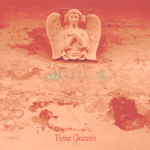Pieros
 Thealbum was, in part, recorded live in St. Augustine Church, Galway andthe cover art reflects the religious content, not just with the angelon the cover, but in the slip the package is housed in. It immediatelyreminded me of many of the Virgin Mary shrines I've seen and it made mewonder: what is Aranos up to? The first four tracks have all thebeautiful echo and warmth a cathedral can possibly provide, but for themost part these songs are composed of drums, bass, organs, and violinplayed at very subdued levels. When "Yevka Sings" hits, it's quite ashock because the choral chanting is so utterly sublime and powerfulabove the instrumentation that its emotional and physical impact canonly be compared to being smacked gently by a massive diesel engine.The music caught me so off guard that I felt my stomach drop and Iimmediately began the song over just so I could prepare myself for itand feel the vocal bliss about to come. I'm not sure if this quartet ofreligiously soaked music is supposed to share or counterpoint anyfeelings raised by No Religion (though "Breath of Unknowing" comes awfully close to sharing a name with the mystical text The Could of Unknowing),but what is obvious is that Aranos is capable of bringing out the moreomni benevolent emotions tied with good mystical or "religious" music.The final six tracks employ varied methods of making music to create acarnival-like atmosphere, a whirlwind of musical ideas that, as far asI can tell, share little to no relation with the first part of thealbum. The atmosphere is almost always soft and careful, as though itwere made to procure images of prowlers or ghosts shifting through thetrees and tall grass at night, but in other places Aranos comes rightout of hiding to paint slightly more vivid sound pictures housed inspastic movements and rock n' roll attitude. "Crab Life" sounds exactlylike its title; small sounds jumping and skipping about, recalling theshuffled steps of crab on the ocean floor. "Silver Goat," on the otherhand, is fronted by Aranos' unmistakable and piercing voice, the musica galloping mix of staccato violins and racing rhythms propelled by afinal, violent movement. This is perhaps Aranos' most varied album, butalso one of his most consistently enjoyable. Other albums by him mayonly be appropriate for certain moods, but I keep coming back to thisalbum and finding that it adheres to almost any of my capriciouslistening needs.
Thealbum was, in part, recorded live in St. Augustine Church, Galway andthe cover art reflects the religious content, not just with the angelon the cover, but in the slip the package is housed in. It immediatelyreminded me of many of the Virgin Mary shrines I've seen and it made mewonder: what is Aranos up to? The first four tracks have all thebeautiful echo and warmth a cathedral can possibly provide, but for themost part these songs are composed of drums, bass, organs, and violinplayed at very subdued levels. When "Yevka Sings" hits, it's quite ashock because the choral chanting is so utterly sublime and powerfulabove the instrumentation that its emotional and physical impact canonly be compared to being smacked gently by a massive diesel engine.The music caught me so off guard that I felt my stomach drop and Iimmediately began the song over just so I could prepare myself for itand feel the vocal bliss about to come. I'm not sure if this quartet ofreligiously soaked music is supposed to share or counterpoint anyfeelings raised by No Religion (though "Breath of Unknowing" comes awfully close to sharing a name with the mystical text The Could of Unknowing),but what is obvious is that Aranos is capable of bringing out the moreomni benevolent emotions tied with good mystical or "religious" music.The final six tracks employ varied methods of making music to create acarnival-like atmosphere, a whirlwind of musical ideas that, as far asI can tell, share little to no relation with the first part of thealbum. The atmosphere is almost always soft and careful, as though itwere made to procure images of prowlers or ghosts shifting through thetrees and tall grass at night, but in other places Aranos comes rightout of hiding to paint slightly more vivid sound pictures housed inspastic movements and rock n' roll attitude. "Crab Life" sounds exactlylike its title; small sounds jumping and skipping about, recalling theshuffled steps of crab on the ocean floor. "Silver Goat," on the otherhand, is fronted by Aranos' unmistakable and piercing voice, the musica galloping mix of staccato violins and racing rhythms propelled by afinal, violent movement. This is perhaps Aranos' most varied album, butalso one of his most consistently enjoyable. Other albums by him mayonly be appropriate for certain moods, but I keep coming back to thisalbum and finding that it adheres to almost any of my capriciouslistening needs.samples:
Read More

